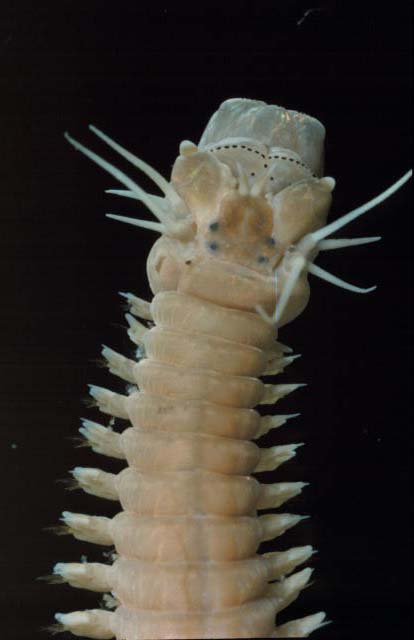|

|
About
polychaetes
Diagnosis
 Polychaetes, like other members of the phylum Annelida, consist of two
presegmental regions, the prostomium and peristomium, a segmented trunk
(metastomium) and a postsegmental pygidium. The nuchal organs, a pair
of chemosensory structures on the postero-lateral margin of the prostomium,
are apparently the only synapomorphy of the Polychaeta which distinguishes
them from other Annelida (Rouse &
Fauchald, 1995). Nuchal organs vary from well-developed posteriorly
projecting loops to inconspicuous pits or grooves. The largest nuchal
organs are found in the Amphinomidae and the Euphrosinidae, where the
ciliated folds on the caruncle represent the nuchal organs; in many other
families nuchal organs are not easily seen. Rouse
& Fauchald (1995) suggested that Annelida can be a monophyletic
taxon only by assuming that chaetae arose independently on the Echiura
and the 'Annelida'. Subsequently, Rouse
& Fauchald (1997) found that the Annelida was monophyletic, though
weakly supported, and consists of the Clitellata (earthworms, other oligochaetes,
and leeches) and the Polychaeta.
Polychaetes, like other members of the phylum Annelida, consist of two
presegmental regions, the prostomium and peristomium, a segmented trunk
(metastomium) and a postsegmental pygidium. The nuchal organs, a pair
of chemosensory structures on the postero-lateral margin of the prostomium,
are apparently the only synapomorphy of the Polychaeta which distinguishes
them from other Annelida (Rouse &
Fauchald, 1995). Nuchal organs vary from well-developed posteriorly
projecting loops to inconspicuous pits or grooves. The largest nuchal
organs are found in the Amphinomidae and the Euphrosinidae, where the
ciliated folds on the caruncle represent the nuchal organs; in many other
families nuchal organs are not easily seen. Rouse
& Fauchald (1995) suggested that Annelida can be a monophyletic
taxon only by assuming that chaetae arose independently on the Echiura
and the 'Annelida'. Subsequently, Rouse
& Fauchald (1997) found that the Annelida was monophyletic, though
weakly supported, and consists of the Clitellata (earthworms, other oligochaetes,
and leeches) and the Polychaeta.
[adapted from Hutchings & Fauchald, 2000]
Ecological significance
Polychaetes are highly abundant and/or diverse in most marine habitats,
especially such benthic communities as soft sediments, algal turfs and fouling communities. Based on our sampling of these environments in southern Australia, polychaete worms often represent about half of all species of macrobenthic invertebrates. Nearly half of all specimens sorted from samples washed over the 0.5 or 1 mm sieves will also probably be polychaetes.
Polychaetes exhibit a wide range of feeding strategies, ranging from those which are carnivores, deposit feeders, suspension feeders, herbivores, and opportunistic species. A few species are parasitic and some are commensal such as the myzostomids. Others live in deep sea vents and lack guts and obtain their energy requirements on the symbiotic chemoautotrophic bacteria which multiply in the endoderm of the trunk segments during the post settlement phase.
Polychaetes play an important role in marine food chains. Some groups, such as the capitellids and arenicolids, are deposit feeders and swallow mud and feed on the algae attached to the particles. Others, such as the sabellids and serpulids, are suspension feeders and feed on suspended particles. Polychaetes also include active predators, scavengers and grazers of algae. Many polychaetes are eaten by other polychaetes and other marine invertebrates as well as fish and wading birds. So polychaetes occupy several levels within the food chain. Polychaetes include many species whose sensitivity to reduced oxygen levels or to heavy metals is well understood, and they can be useful pollution indicators.
|
 |